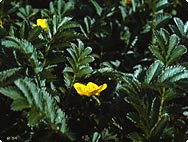
Potentilla anserina L.
Silverweed

History
Although silverweed was already used as a remedy by physicians in olden times, it is primarily a plant of folk medicine. Theophrastus and Dioscorides described it under the names pentaphyllon and quinquefolium respectively; both names mean ‘five-leaf’. Today it is not absolutely certain whether it was Potentilla anserina that was referred to. In medieval herb books, silverweed is described extensively and recommended for diarrhoea and haemorrhages. Lonicerus called the plant ‘Genserich’ (= gander) and used it for stomach ache, as a treatment for wounds, and for eye complaints. He wrote that it “drives off the white flow of women”. The name Potentilla is probably the diminutive of the Latin potentia, meaning ‘power’, referring to the plant's potent healing power. The species name anserina is derived from the Latin anser, meaning ‘goose’. The plant received this name because the herb was chopped, mixed with clover and fed to young geese.

Botanical characteristics
Silverweed is a perennial plant with a short, woody rootstock that sends out runners up to 80 cm long. New roots sprout at nodules on the runners, producing thick carpets. The leaves form a rosette with 13 to 21 interruptedly pinnate, opposing leaflets. These are stalked (petiolate), acutely serrate, and silvery-white and silkily haired on the underside. Individual apical flowers stand on the leafless stalk with five oval, golden-yellow petals and numerous stamens.Silverweed flowers from June to October.

Habitat
Silverweed occurs naturally in temperate zones and is often found on wasteland. It is not particularly fussy, but prefers loamy soils in sunny sites in meadows, the margins of forests and paths, on waste areas, or in gardens up to an elevation of 1600 metres.
Preparation
A.Vogel produces a homoeopathic mother tincture in accordance with the actual HAB from the fresh, aerial parts of the silverweed plant at the time of flowering. The subsequent potentising is carried out manually.The dried herb is customarily used to prepare a tea. The thick rootstocks and young sprouts were formerly used as a wild vegetable.
A.Vogel Blog – Natural and Healthy
Inspiration for a healthy life!
HERBAMARE SOUP-ER SOUPS!
DOWNLOAD YOUR FREE RECIPE BOOKLET!
8 healthy, hearty and delicious homemade soups.
Supporting a healthier happier you
“Nature is just about the best thing we’ve got!“
Alfred Vogel's guide to leading a healthy and happy life
Healthy & nutritious dinner ideas
Get new recipes in your inbox every month. Sign up now